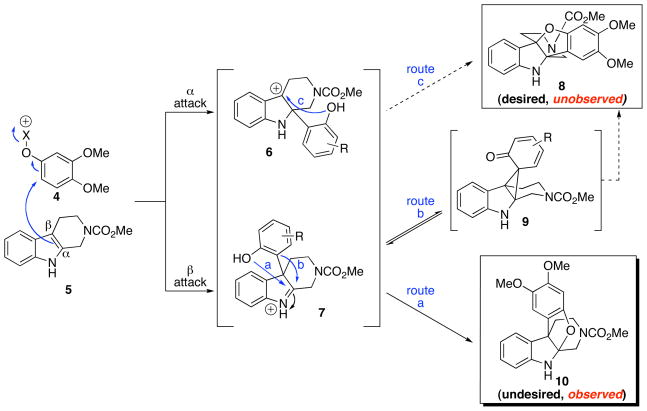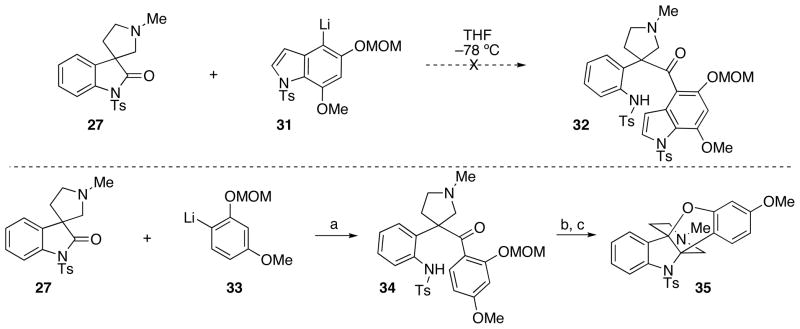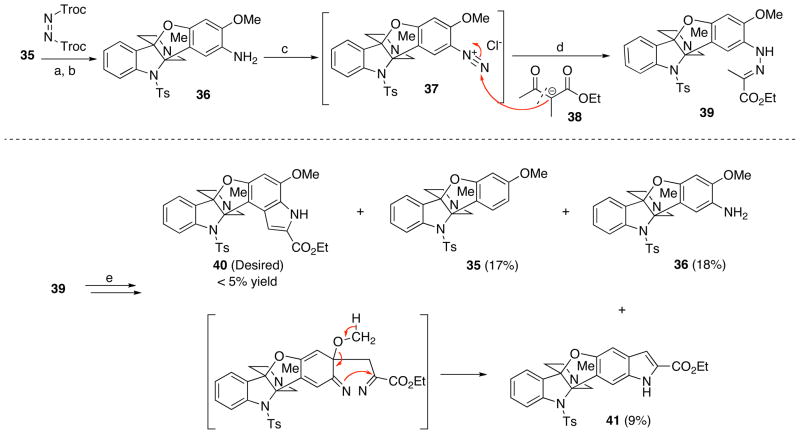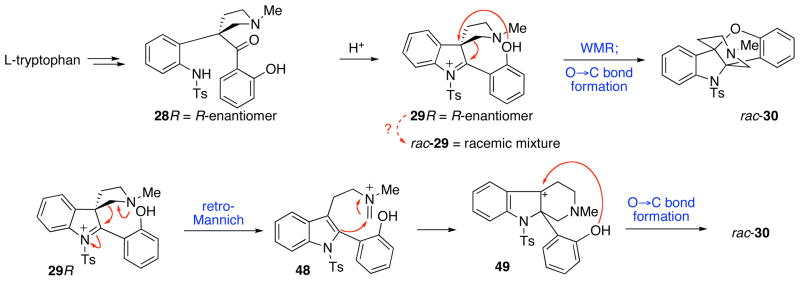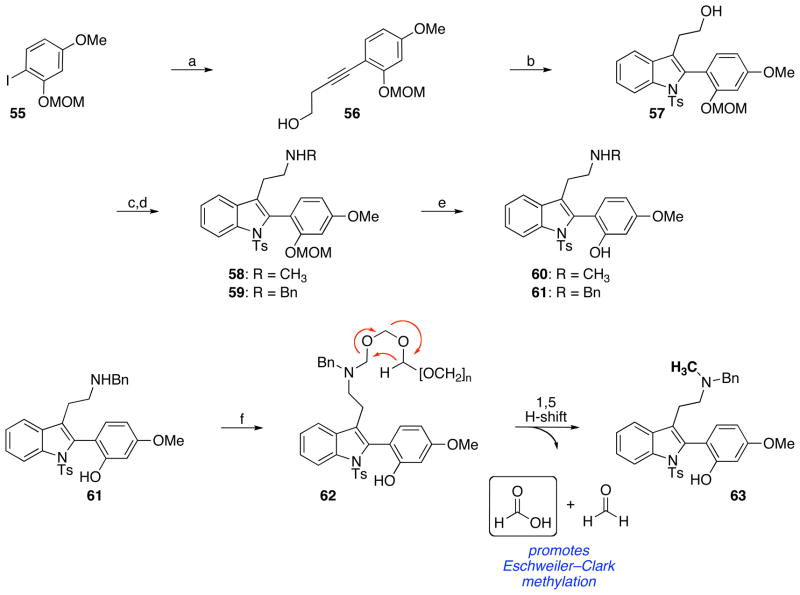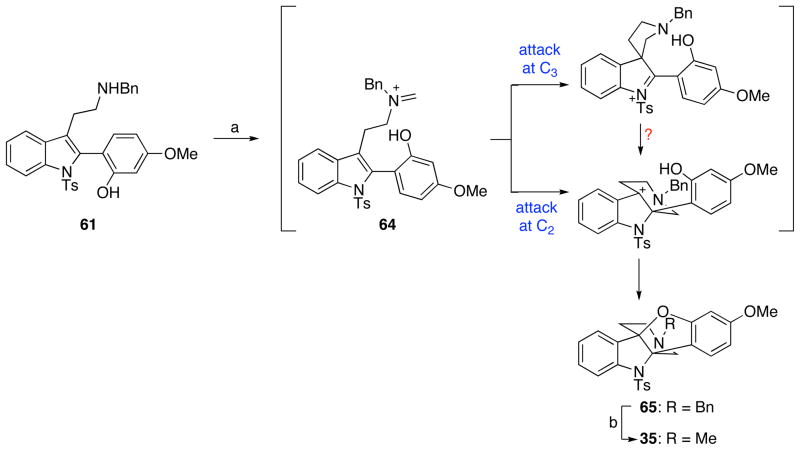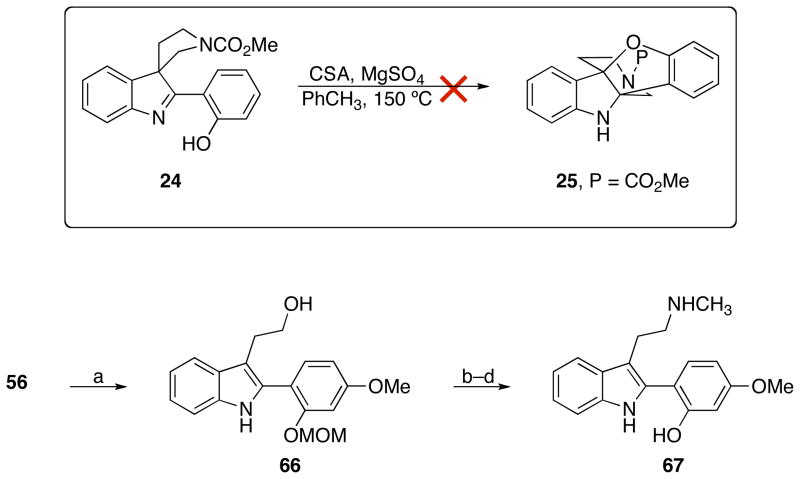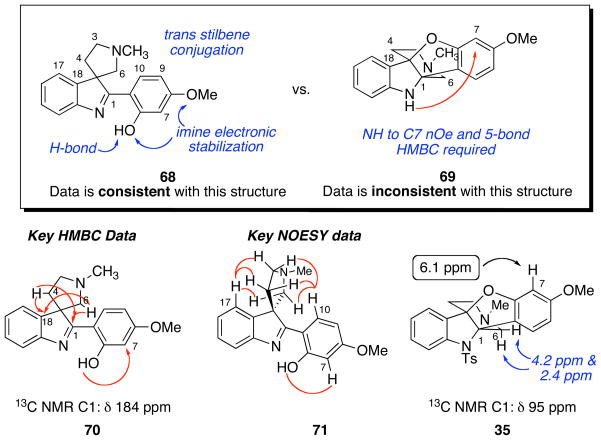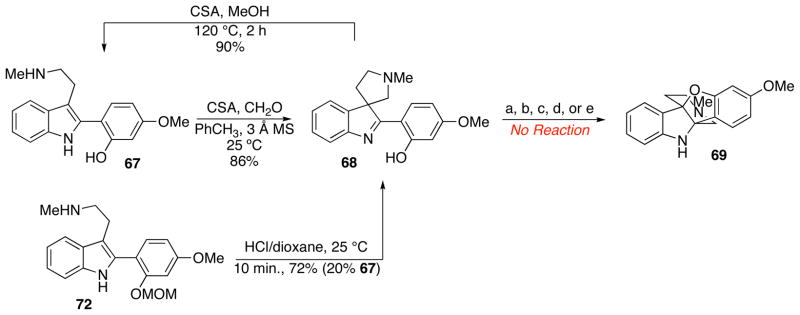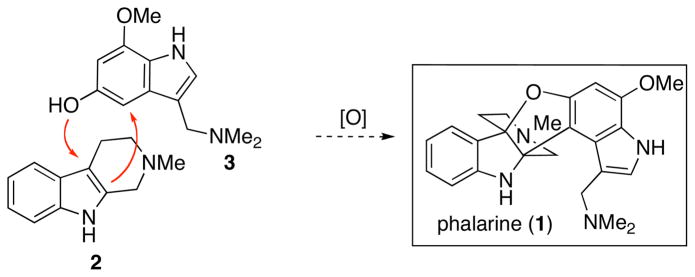Abstract
The furanobisindole alkaloid, phalarine, possesses a unique structural framework within the alkaloid family of natural products. Our laboratory recently disclosed the racemic total synthesis of phalarine, featuring an efficient azaspiroindolenine rearrangement; this achievement is revisited in detail. Upon completion of the first-generation total synthesis, we explored some interesting mechanism-level issues with regard to the key azaspiroindolenine rearrangement. These investigations provided valuable insights into the mechanism of racemization during the azaspiroindolenine rearrangement en route to synthetic phalarine. In addition, in the course of these studies, we demonstrated the Pictet–Spengler capture reaction for C2-aryl indoles, and successfully isolated the elusive azaspiroindolenine intermediate of the Pictet–Spengler reaction. Key insights into the remarkably subtle stereoelectronics that govern this rearrangement for C2-arylated indoles are discussed.
Colegate and colleagues described the isolation, from Phalaris coerulescens, of a novel furanobisindole alkaloid, named phalarine (1).[1] It was the novelty of its structure, rather than any reports of promising biological properties, which drew the attention of our laboratory to phalarine. Following consideration of a variety of prospective formats for its total synthesis, there emerged a plan for reaching the natural product. We were also attracted to the project (vide infra) because it would touch upon some core issues and themes that have triggered much discussion and research in the field of indole alkaloids since the 1950s.[2] This account returns to our successful effort to complete the total synthesis of racemic phalarine and revisits our inability to render this process enantiospecific. As will be seen, the investigations described herein have resulted in new insights into the apparent electrophilic substitution at C2 in indoles.
Our fascination with the propellerane structure of phalarine was further enhanced by the simplicity of the pathway proposed for its biosynthesis.[1] It was suggested that oxidative heterocoupling of the common β-carboline (2) with, for instance, a suitable gramine derivative 3, could result in convergent access to the highly complex natural product core in a single transformation. Further supporting the plausibility of this hypothesis were reports that 2 was isolated from P. coerulescens,[3] and that gramine derivative 3 had been isolated from Phalaris spp.[4] Attempted reduction of this hypothesized transformation to practice would serve as the launching point for our investigations. We first sought to realize a demonstration of synthetic feasibility, using the model veratryl derivative 4.
Initial efforts to achieve the direct oxidative heterocoupling of 4 and 5 provided exclusively the regioisomer 10 (Figure 2).[5] Thus, our presumed biosimulation was undermined by preferred electrophilic attack at the β- rather than the α-position of the indole segment of the β-carboline system. The observed product, 10, arises from eventual C-O bond formation of species 7. Attempts to overcome this undesirable mode of reactivity were unsuccessful. Of course, the preference for electrophilic attack at the β- rather than the α-carbon of an indole is, in itself, not surprising.[6]
Figure 2.
Model System for Oxidative Coupling Methodology with Electrophile 4.
We next sought to exploit an indolenine such as 11, generated through Witkop oxidation of 5 (Figure 3),[7, 8] hoping to combine 11 with 12 in a process which would start with O-alkylation of the phenol at the β-position of the indole, followed by C-alkylation at the α-position, to reach 8. Alternatively, it was envisioned that initial C-alkylation at the α-carbon in an SN2′ sense, followed by O-alkylation at the β-carbon, might also lead to 8. However, in practice, the product obtained, as determined by X-ray crystallographic analysis, was compound 15. Formation of 15 presumably had to involve, at some stage, an unanticipated tautomerization of 11 to generate a bis-enamine like structure (13 or 14), which advances to the undesired 15.[5] This product could arise from either of two pathways, shown in Figure 3.
Figure 3.
Model System for Oxidative Coupling Methodology with Electrophile 11.
In the light of these setbacks, we decided to pursue a modified strategy toward phalarine, wherein the C–C bond between the carboline α-carbon and the ortho-hydroxyaryl moiety would be in place prior to the formation of the elusive C–O bond at the β-position of the β-carboline. In this strategy, the carboline moiety would be constructed through ring expansion of an azaspiroindolenine of the type 17 (Figure 4). It was proposed that the rearrangement would generate a hexahydrocarboline intermediate, 18, bearing a positive charge at the β-carbon of the indoline, thus setting the stage for the critical O–C4a bond formation to provide 19. We envisioned gaining access to the requisite azaspiroindolenine (17) through derivatization of an azaspirooxindole of the type 16.
Figure 4.
Ring-Expansion Strategy Toward Phalarine (1).
We first attempted to explore the feasibility of this proposed bond reorganization in the context of azaspiroindolenine 24, whose rearrangement would provide the phalarine core compound, 25 (Scheme 1). The synthesis of key substrate 24 commenced with β-carboline 20, which was advanced to spirooxindole 22 in a straightforward fashion. Coupling of 22 with aryl lithium 23, followed by removal of the MOM group, provided the key precursor spiroindolenine, 24. In the event, however, all attempts to accomplish rearrangement of 24 were unsuccessful, and resulted primarily in recovery of unreacted starting material. We considered two likely factors that may have contributed to the failure of this transformation. First, one might expect that the urethane-bound methylene carbon would possess a relatively low propensity for migration. Furthermore, hydrogen bonding between the phenolic moiety and the nitrogen atom of the indolenine functionality could serve to restrict free rotation around the C9a–C2′ bond. Rotation around this bond would be necessary to establish the phenyl ether–C4a bond, thus driving the ring-expansion reaction in the required direction.
Scheme 1.
Attempted Ring Expansion of Intermediate 24. Key: (a) methyl chloroformate, CH2Cl2/sat. NaHCO3 (1:1), RT, 99%; (b) NBS, THF/H2O then AcOH, 0 °C, 84%; (c) Boc2O, Et3N, DMAP, CH2Cl2, 84%; (d) 23, THF, −78 °C; (e) TFA, CH2Cl2, 54% (two steps). NBS = N-bromosuccinimide, Boc = tert-butoxycarbonyl, DMAP = 4-(dimethylamino)-pyridine, MOM = methoxy-methyl, TFA = trifluoroacetic acid.
With these considerations in mind, we sought to generate a particularly reactive iminium equivalent, such as 29 (or its hydrate, 28), in which the urethane is replaced with an N-methyl function and an activating tosyl function is incorporated at N1 in the precursor, 28. As outlined in Scheme 2, the synthesis of 28 was accomplished in a manner analogous to that employed earlier in the synthesis of 24 (Scheme 1). In the event, upon treatment with CSA at 150 °C, compound 28 underwent rearrangement to furnish 30 (52% yield) presumably through an intermediate of the type 29. The structure of 30 was confirmed through X-ray analysis of its methiodide derivative. Thus, with the appropriate activating motifs incorporated on the substrate, the desired rearrangement of azaspiroindolenine 28 to the phalarine precursor 30 was indeed achievable.
Scheme 2.
Successful Ring Expansion of Intermediate 28. Key: (a) LAH, THF, 99%; (b) NBS, THF/H2O/AcOH (1:1:1.5), RT, 79%; (c) LiHMDS, TsCl, THF, 0 °C, 89%; (d) 23, THF, −78 °C, 94%; (e) TFA, CH2Cl2, 0 °C to RT, 95%; (f) CSA, PhCH3, 150°C, 52%; LAH = lithium aluminum hydride, HMDS = bis(trimethylsilyl)amide, Ts = p-toluenesulfonyl, CSA = (±)-camphor-10-sulfonic acid.
We next explored the applicability of this general protocol to the total synthesis of phalarine itself. In our early investigations, we imagined a highly convergent strategy involving the coupling of a complex aryl-lithium of the type 31 with oxindole 27, to furnish a late-stage intermediate of the type 32 en route to phalarine. However, the yields obtained from coupling of more densely functionalized aryl-lithium species such as 31 were prohibitively low. We hoped to accomplish the aryl-lithium coupling with a simpler nucleophile. After azaspiroindolenine rearrangement, the indole functionality would be introduced in the concluding phase of the synthesis. As shown in Scheme 3, oxindole 27 was successfully coupled with aryl-lithium 33, to afford intermediate 34. Following deprotection of the phenol and exposure of the resultant product to the action of CSA, the phalarine core, 35, was in hand. The structure of this intermediate was verified by X-ray crystallography of the permethylated derivative.[9]
Scheme 3.
Successful Strategy to the Core of Phalarine. Key: (a) THF, −78 °C, 96%; (b) TFA, CH2Cl2, 0 °C, 98%; (c) CSA, toluene, 130 °C, 72%.
We now directed our attention to the construction of the final indole subunit and the completion of the phalarine total synthesis, envisioning installation of the indole through a traditional Fischer indole synthesis.[10, 11] Toward this end, compound 35 was advanced to intermediate 39 through recourse to a straightforward sequence involving Japp-Klingemann condensation with β-ketoester 38 (Scheme 4).[12–14] However, all attempts to accomplish Fischer indolization with intermediate 39 were unsuccessful, resulting in formation of a number of side products arising from a variety of undesirable reaction pathways. For instance, as shown in Scheme 4, competing pathways included loss of the carbazate side chain (35), scission of the hydrazone N–N bond (36) and a surprising ipso indolization/reductive demethylation sequence, leading to the formation of 41.[15, 16]
Scheme 4.
Fischer Indole Formation Approach. Key: (a) Troc-N=N-Troc, TFA, 95%; (b) Zn dust, AcOH, 88%; (c) NaNO2, aqueous HCl, −5 °C; (d) 38, aq KOH, EtOH, −5 °C, 81%; (e) TsOH, toluene, 80 °C, < 5%.
Based on the results of these and other studies, we hypothesized that the presence of the methoxy group was impeding Fischer-type indolization. Fortunately, we were able to achieve success through recourse to the Gassman oxindole synthesis (Scheme 5).[17–19] The Gassman method was found to be relatively impervious to the effects of the methoxy group, and, following presumed [2,3] sigmatropic rearrangement, intermediate 42 was in hand. Following adjustment of the oxidation state, installation of the gramine side chain,[20] and removal of the tosyl protecting group, we successfully accomplished the total synthesis of phalarine (1), albeit in racemic form.
Scheme 5.
Completion of the Synthesis. Key: (a) 1. MeSCH2CO2Et, SO2Cl2, CH2Cl2, −78 °C; 2. 36, proton sponge, CH2Cl2, −78 °C; 3. Et3N, CH2Cl2, −78 °C to RT; 4. AcOH, 2h, 66%; (b) BH3, THF, 0 °C; (c) Raney Ni, EtOH, 90% for 2 steps; (d) N,N-dimethylmethylene ammonium chloride, AcOH, 74%; (e) Na(Hg), Na2HPO4, MeOH, 0 °C to RT, 90%.
Upon realization of the total synthesis mission with conciseness and efficiency, we turned to some interesting mechanism-level issues with regard to the pathway of the key skeletal rearrangement (cf. 44→35). It seemed likely that 44 would progress to 45, following well-charted organic chemistry. Two alternative and potentially converging pathways presented themselves for advancing from 45→35; they are shown in Figure 5.[21] Path (a) involves 1,2-Wagner–Meerwein like rearrangement (WMR) of the N-methylene group to establish the β-carboline motif, bearing cationoid character at C3 of the hydroindole system (see structure 46). Neutralization of the tertiary bridgehead cationic center in 46 by the proximal phenolic hydroxyl group provides much of the core skeleton of phalarine.
Figure 5.
Skeletal Rearrangement (44→35) en route to Phalarine (1).
By contrast, path (b) sets forth a different perception. Here, it is contemplated that a retro-Mannich cleavage of 45 gives rise to structure 47. The iminium linkage in 47 can serve as an electrophilic locus, prompting Pictet–Spengler like closure at C2 of the 2-aryl indole moiety. At this stage, the proximal phenol attacks the cationoid species, akin to 46 formed in path (a). With O–C bond formation accomplished, compound 35 would be in hand.
Presumptive evidence supports the intermediacy of an achiral iminium species (such as 47) in the pathway. Thus, a related model compound precursor, 28R, had been prepared in enantiomerically defined form from L-tryptophan (Figure 6).[22] Exposure of 28R to the same reaction conditions as were used with compound 44, indeed gave rise to 30, i.e. the analog of 35. A central observation was that compound 30, arising from 29R, emerged in racemic form even in the earliest stages of the reaction. Moreover, recovered 28R maintained its optical integrity.[22] As striking as these results are, they do not, in and of themselves, fully establish the role of achiral 48 as the terminal decisive cyclization entity en route to rac-30. While the interpretation offered above is certainly a reasonable possibility for reaching 30, another pathway had to be considered. This variation envisions intermediate 48 to reach racemic system 29. By this view, the phalarine core (rac-30) would have been formed through the WMR step, i.e. rac-29→rac-30. The role of the Pictet–Spengler intermediate iminium salt (48) would be only that of providing the means for racemization of the original structure 28R.
Figure 6.
Attempted Route to Enantioenriched Phalarine.
In the research described below, we set for ourselves several goals. The first was to gain a better insight into the mechanistic issues raised by the above racemization event. Furthermore, we hoped to conduct the phalarine total synthesis in an even more concise fashion than that shown in Schemes 3–5. Finally, it was anticipated that through superior mechanism level insights and a modified synthetic route, we would be able to achieve an as-yet unfulfilled goal, i.e. a total synthesis pathway to the natural enantiomer of phalarine. Conceivably, such a pathway, if well understood, might help in the assignment of the absolute stereochemistry of phalarine.
Our second generation studies centered around a new proposal for reaching the core system (Figure 7). It was anticipated that a suitable tryptamine derivative bearing the aryl group at C2 (see 50) might react with a C1 fragment, presumably formaldehyde, giving rise to a Schiff base salt (cf. 51). Attack of the iminium linkage at C2 would generate cation 52, the analog of 46. Neutralization of the cation by the proximal phenol would complete elaboration of the phalarine core (53). Alternatively, the 2-substituted tryptamine might suffer attack at C3, producing 54. Wagner–Meerwein type rearrangement of 54 would give rise to 52, and thence to 53. Thus, in the context of this hypothetical alternative route to the phalarine core we would be probing questions not unlike those that arose in the course of the azaspiroindolenine route (see 29→30) discussed above.
Figure 7.
A Proposed Concise Route to the Phalarine Core.
The central question presented is one that has been at the core of alkaloid chemistry for decades: What is the operative mechanism of the Pictet–Spengler reaction? Critical insights arose from Jackson’s seminal studies on the mechanism of carbazole[2, 23–25] or carboline[21, 26] formation and Heathcock’s study on amino substituted cyclopent[b]indole,[27] where their data each support a mechanism for preferred C3 attack.[28] However, the presumed spirocyclic azaspiroindolenium ion has never been isolated. It had been argued that the kinetics of rearrangement of such species far exceed those of spirocycle formation.[29] Indeed, as we commenced our work in this arena, we were not unmindful of the well-established limits of mechanistic understanding for the proposed reactions. In this setting, the results described below are particularly interesting.
Our proposed second generation synthesis commenced with a Sonogashira coupling of 55[30] and 3-butyn-1-ol, thereby providing alkyne 56 (Scheme 6). The Pd-catalyzed union of 56 and N-tosyl-2-iodoaniline[31, 32] provided a 2:1 mixture of regioisomeric indoles,[33] of which the desired regioisomer (57) was predominant (83% yield).[32, 34] A series of standard operations yielded indole derivatives 58 or 59. Deprotection of the MOM group of these precursors afforded 60[35] or 61, respectively. Surprisingly, treatment of 61 with paraformaldehyde, CSA, and Na2SO4 led to isolation of a reductively N-methylated product 63.
Scheme 6.
Unanticipated N-Methylation Mechanism. Key: (a) but-3-yn-1-ol, Pd(PPh3)4, CuI, Et3N, DMF, 60 °C, 76%; (b) 2-iodo-N-tosylaniline, Pd(OAc)2, Et3N, NMP, μW, 125 °C, 40 min, 83% (2:1 regioisomers); (c) I2, PPh3, imidazole, CH2Cl2, 93%; (d) CH3NH2, THF, 50 °C, sealed tube, 97%, or with BnNH2 90%; (e) 5% TFA, CH2Cl2, −10°C, from 58 84%, from 59 98%; (f) [CHO]n, CSA, toluene, 130 °C, 54%
The formation of compound 63 warrants comment since there was no obvious reducing agent to enable the observed reductive alkylation. It is interesting to conjecture about the possibility that reductive methylation occurs in the setting of the mixed acetal 62, via a 1,5 hydride transfer. Thus, by this view, the effective reducing agent would have been a mole of formaldehyde, which emerged in the formic acid oxidation level.[36, 37]
In the end, the problem of the unwanted reductive methylation was solved. Reaction of 61 with formalin provided the desired product 65 in excellent yield (Scheme 7).[38] Furthermore, compound 65 was converted to the previously known compound, 35.[9, 39] This pathway corresponds to an interesting extension of the logic of the classical Pictet–Spengler reaction[40] to a substrate bearing a 2-aryl group at C2 of the indole. Rather than producing a tetrahydro β-carboline product as is the case when C2 is free, here there is apparently produced the transient cation from 64, which, on C-O bond formation leads directly to the phalarine core.
Scheme 7.
The Pictet–Spengler Capture Reaction. Key: (a) formalin, CSA, toluene, 4Å molecular sieves, 120 °C, 80%; (b) H2, 10% Pd/C, formalin, MeOH, 54% (unoptimized).
Of course, from the perspective of synthetic efficiency and elegance, the lack of strong regioselection in the synthesis of 61 had compromised the attractiveness of the new route. However, the chemistry described in Schemes 6 and 7 provided a platform for probing the mechanistic issues in a fresh context and served as a feasibility demonstration that the source of the racemization discussed in our earlier work on the azaspiroindolenine rearrangement (see 28R→rac-30) could well involve rapid retro-Mannich reaction to generate the achiral intermediate 48.[22] Thus, such an intermediate is obviously being generated in the pathway starting with 61.
In a related effort, we sought to investigate the stereoelectronic parameters that seem to govern the azaspiroindolenine rearrangement. These studies arose from the observation that compound 44 underwent successful rearrangement whereas the Na-unsubstituted, Nb-CO2Me compound 24[41] (Scheme 8) could not be made to rearrange.[22] The hypothesis at this juncture was that the methyl carbamate reduced the migratory aptitude of the azaspiroindolenine methylene below the threshold for reactivity, a reasonable assertion in accord with the observations of Woodward in his synthesis of strychnine, where an Nb-tosyl was similarly invoked, in part, to stabilize a related structure.[42] Therefore, we proposed investigation of compound 67 (as a surrogate for the Nb-CH3 variant of 24) to directly assess the role of the methyl carbamate in this reaction expecting to observe a successful Pictet–Spengler capture reaction.
Scheme 8.
Reagents and Conditions: (a) 2-iodotrifluoroacetanilide, Pd(OAc)2, Et3N, NMP, μW, 30 min, 125 °C, 45% (2:1 regioisomers: 66 major); (b) I2, PPh3, Imidazole, CH2Cl2, 86%; (c) 2.0 M CH3NH2/THF, 50 °C, 81%; (d) 4 N HCl/Dioxane, −10 °C, 98%.
Relying on our methodology to generate C2 aryl tryptamine derivatives, described above, we were able to prepare expeditiously target structure 67. Indeed, upon treatment of 67 under our standard conditions, compound 67 quantitatively provided a single compound in 85% yield in less than 30 min. Inspection of the spectroscopic features of the product revealed that we had isolated the azaspiroindolenine intermediate of an “arrested” Pictet–Spengler reaction (68, Figure 8). Seemingly, after initial Mannich cyclization at C3, the resulting azaspiroindolenine, 68, had failed to undergo rearrangement to the desired ring expansion product as had been observed with 45, 29, and 61. This elusive structure had not been directly isolated from these reactions,[43] and represents a key observation with regard to elucidating the mechanism of this type of Pictet–Spengler reaction, wherein C2 of the indole is substituted.
Figure 8.
Key NOESY and HMBC Interactions Consistent with Structure 68.
A summary of the distinguishing spectroscopic features leading to the assignment of 68 is provided in Figure 8. Three diagnostic 1H-NMR features indicative of propellerane core formation were absent. Key to the assignment were the absence of the large chemical shift difference (>1.5 ppm) of the diastereotopic hydrogens expected at C6 of a phalarine (cf. 35), and an upfield shifted hydrogen observed at 6.1 ppm (see position 7 in 35). These absences, in combination with diagnostic HMBC (70), NOE (71), and 13C-NMR data (new resonance at 184 ppm, consistent with an imine), unambiguously established the structure as 68.
These findings reflect the underlying subtleties that are required for the prephalarine→phalarine type rearrangement to occur. For instance, the p-OMe substituent in 68 could well impart significant stabilization to the planar trans-stilbene-like system, concomitantly reducing imine electrophilicity, and resulting in an isolable intermediate that is stable to hydrolysis and chromatography.[44] We further hypothesize that this imine may benefit from additional stabilization via an internal hydrogen bond to the phenolic hydroxyl group, which further aids in maintaining the planarity of the system to maximize the benefits of extended conjugation. Of major significance, is the Na-tosyl group in 34, which plays a dual role in activating the rearrangement process. It not only allows for the formation of an exceptionally reactive iminium species for rearrangement, but steric bulk may prevent the adoption of the planar stilbene geometry. Hence, the tosyl group embodies a subtle, yet critical, stereoelectronic role in the success of the rearrangement. In total, the combination of this special set of parameters (C2 electron rich aryl substituted indole, Na-H indole, trans stilbene stabilization) permitted the serendipitous isolation of this long sought-after intermediate of the Pictet–Spengler reaction. These data offer strong support that the Pictet–Spengler reaction proceeds through an initial nucleophilic attack exclusively from indole C3, at least when C2 is substituted.
The remarkable stability of 68 permitted a wide range of investigations to enable reactivity. However, in the event, subjection of 68 to the reaction conditions for its formation without formalin accomplished clean reversion to 67, indicating that the reaction is, in fact, reversible. Interestingly, 68 could be directly prepared from 72 under carefully controlled conditions, in which the phenolic MOM group itself could be utilized as a surrogate for formaldehyde. However, we were unable to realize our ultimate goal; the conversion of 68 to 69. Resubjection of 68 to the reaction conditions, including more forcing conditions or reaction with alternative acids, treatment with base, reaction in polar solvents (to assess role of internal hydrogen bond), and exposure to a variety of Lewis acids were all unsuccessful. Harsher methods, including attempted TFAA-mediated O→N acyl transfer or treatment with Et3N and TsCl[42] to prepare Na-protected 69, were also unsuccessful (Scheme 9 and see Supporting Information). In sum, these data provide additional illustration of the fact that the Na-protecting group is critical in activating the resultant iminium for nucleophilic attack.
Scheme 9.
Attempts to promote 1,2 alkyl shift of 68 to desired product 69. Key: (a) N-Acyl transfer: TFAA, toluene, 4Å MS, 100 °C, 4h, decomposition; (b) “retro-Woodward”: pyridine, Et3N, CH2Cl2, up to 50 °C, recovered SM; (c) Lewis acid, toluene, up to 80 °C, up to 18h, no reaction; (d) Cs2CO3, MeCN, 120 °C, 2h, decomposition; (e) CSA, CH2O, MeOH, 3Å MS, up to 160 °C, 2h, recovered SM.
In conclusion, our program for the construction of the unusual core of phalarine led us to several interesting findings at the level of synthesis, notably the pre-phalarine→phalarine rearrangement and its requirements. The loss of optical activity in the production of rac-30 from 28R is best interpreted by a retro-Mannich–Mannich equilibrium as the source of racemization. This finding led to the discovery of a Pictet–Spengler initiated sequence leading to 65 and 35.
The isolation of the azaspiroindolenine intermediate 68 establishes that, at least in this case, the mechanism of the Pictet–Spengler capture reaction starts with C3 attack, culminating in 1,2-alkyl shift and carbocation capture to provide the desired products. The successful isolation of 68, as well as the failure of 24 to rearrange, provides key insights into the remarkably subtle stereoelectronics that are required for progression to adducts such as 65 or 35. It is hoped that lessons of this sort will continue to encourage the study of the fascinating chemistry and structural architecture that Nature provides for its curious students.
Supplementary Material
Figure 1.
Proposed Biosynthetic Route to Phalarine (1).
Acknowledgments
This work was supported by the National Institutes of Health (Grant HL25848 to SJD).
Footnotes
Supplementary Material. Experimental details and characterization data are available online.
References
- 1.Anderton N, Cockrum PA, Colegate SM, Edgar JA, Flower K, Gardner D, Willing RI. Phytochemistry. 1999;51:153–157. [Google Scholar]
- 2.Jackson AH, Smith P. Chem Commun (London) 1967:264–266. [Google Scholar]
- 3.Anderton N, Cockrum PA, Colegate SM, Edgar JA, Flower K, Vit I, Willing RI. Phytochemistry. 1998;48:437–439. [Google Scholar]
- 4.Mulvena DP, Picker K, Ridley DD, Slaytor M. Phytochemistry. 1983;22:2885–2886. [Google Scholar]
- 5.Chan C, Li C, Zhang F, Danishefsky SJ. Tetrahedron Lett. 2006;47:4839–4841. [Google Scholar]
- 6.Joule JA, Mills K. Heterocyclic Chemistry. Blackwell Publishing; Malden, MA: 2000. pp. 324–379. [Google Scholar]
- 7.Witkop B, Patrick JB. J Am Chem Soc. 1953;75:2572–2576. [Google Scholar]
- 8.Buchi G, Manning RE. J Am Chem Soc. 1966;88:2532–2535. [Google Scholar]
- 9.Li C, Chan C, Heimann AC, Danishefsky SJ. Angew Chem Int Ed. 2007;46:1448–1450. doi: 10.1002/anie.200604072. [DOI] [PubMed] [Google Scholar]
- 10.Fischer E, Hess O. Ber. 1884;17:559–568. [Google Scholar]
- 11.Fischer E, Jourdan H. Ber. 1883;16:2241–2245. [Google Scholar]
- 12.Leblanc Y, Boudreault N. J Org Chem. 1995;60:4268–4271. [Google Scholar]
- 13.Dufresna C, Leblanc Y, Berthelette C, McCooeye C. Synth Commun. 1997;27:3613–3624. [Google Scholar]
- 14.Japp FR, Klingemann F. Justus Liebigs Ann Chem. 1888;247:190. [Google Scholar]
- 15.Ishii H. Acc Chem Res. 1981;14:275–283. [Google Scholar]
- 16.Murakami Y, Takahashi H, Nakazawa Y, Koshimizu M, Watanabe Y, Yokoyama Y. Tetrahedron Lett. 1989;30:2099–2100. [Google Scholar]
- 17.Gassman PG, Gruetzmacher G, Van Bergen TJ. J Am Chem Soc. 1974;96:5512–5517. [Google Scholar]
- 18.Gassman PG, Van Bergen TJ. J Am Chem Soc. 1974;96:5508–5512. [Google Scholar]
- 19.Savall BM, McWhorter WW. J Org Chem. 1996;61:8696–8697. [Google Scholar]
- 20.Kinast G, Tietze LF. Angew Chem Int Ed. 1976;15:239–240. [Google Scholar]
- 21.Jackson AH, Smith P. Tetrahedron. 1968;24:2227–2239. [Google Scholar]
- 22.Li C, Chan C, Heimann AC, Danishefsky SJ. Angew Chem Int Ed. 2007;46:1444–1447. doi: 10.1002/anie.200604071. [DOI] [PubMed] [Google Scholar]
- 23.Ibaceta-Lizana JSL, Jackson AH, Prasitpan N, Shannon PVR. J Chem Soc, Perkin Trans. 1987;2:1221–1226. [Google Scholar]
- 24.Iyer R, Jackson AH, Shannon PVR, Naidoo B. J Chem Soc, Perkin Trans. 1973;2:872–878. [Google Scholar]
- 25.Jackson AH, Naidoo B, Smith P. Tetrahedron. 1968;24:6119–6129. [Google Scholar]
- 26.Jackson AH, Smith AE. Tetrahedron. 1968;24:403–413. [Google Scholar]
- 27.Ganesan A, Heathcock CH. Tetrahedron Lett. 1993;34:439–440. [Google Scholar]
- 28.A notable exception to the dominance of indole C3 attack is for electron rich indoles as originally noted by Jackson and later suggested by Heathcock (see references 24 and 27)
- 29.Jackson AH, Lynch PP. J Chem Soc, Perkin Trans. 1987;2:1215–1219. [Google Scholar]
- 30.Winkle MR, Ronald RC. J Org Chem. 1982;47:2101–2108. [Google Scholar]
- 31.Larock RC, Yum EK. J Am Chem Soc. 1991;113:6689–6690. [Google Scholar]
- 32.Larock RC, Yum EK, Refvik MD. J Org Chem. 1998;63:7652–7662. [Google Scholar]
- 33.The ratio of regioisomers was dependent on reaction conditions. A 4:1 ratio of regioisomers favoring the desired regioisomer was observed in DMF with sodium carbonate as base, however the yield was variable (50–90%). The procedure described in the Supporting Information was highly reproducible albeit with a decreased level of regioselectivity. For interesting discussions on the regioselectivity of the Larock indolization reaction see references 32 and 34.
- 34.Nishikawa T, Wada K, Isobe M. Biosci Biotechnol Biochem. 2002;66:2273–2278. doi: 10.1271/bbb.66.2273. [DOI] [PubMed] [Google Scholar]
- 35.Note that compound 60 was remarkably unstable to both chromatography and storage at room temperature. The half-life of this compound in organic solvents was less than 30 min as observed by TLC.
- 36.Clarke HT, Gillespie HB, Weisshaus SZ. J Am Chem Soc. 1933;55:4571–4587. [Google Scholar]
- 37.Eschweiler W. Ber Dtsch Chem Ges. 1905;38:880–882. [Google Scholar]
- 38.The amine was free based by treatment with sodium bicarbonate. Surprisingly, in protocols where this step was avoided, an undesirable chlorination of the methoxy-bearing aryl ring was observed at the nucleophilic carbon alpha to the methoxy group and para to the phenol. This product was characterized by HNMR, COSY, NOESY, and mass spectrometry where the characteristic 3:1 ratio of molecular ions was observed.
- 39.Encouragingly, using the optimized conditions for compound 61, 60 was persuaded to directly forge 35 in modest yield (40%) where certainly a kinetically competitive degradation of compound 60 accounted for a majority of the loss in conversion for this substrate.
- 40.Pictet A, Spengler T. Ber Dtsch Chem Ges. 1911;44:2030–2036. [Google Scholar]
- 41.Compound 24 was prepared from an aryl lithium insertion into the corresponding oxindole and not from a Mannich-like process (see reference 22).
- 42.Woodward RB, Cava MP, Ollis WD, Hunger A, Daeniker HU, Schenker K. Tetrahedron. 1963;19:247–288. [Google Scholar]
- 43.Note that in Woodward’s synthesis of Strychnine the iminium precursor used was beneficially inactive to Mannich capture, likely due to both the presence of a C2 aryl blocking group and an additional deactivating ethyl ester on the imine (derived from ethyl glyoxlyate). Instead, this intermediate was isolated via trapping the azaspiroindolenine by invoking a base promoted Mannich cyclization with concomitant tosylation of the imine nitrogen in a system that was blocked from further reaction. Our work utilizes no such blocking mechanism and suggests that C2-aryl tryptamine derivatives will only serve as blocking groups in the absence of a suitable trap for the transient benzylic carbocation generated upon 1,2-alkyl migration. It also seems that the blocking capacity of these systems is more a function of the unique stereoelectronics of an unprotected C2-aryl azaspiroindolenine as discussed in this section.
- 44.Interestingly, upon treatment of desmethoxy 67 to identical conditions, the azaspiroindolenine intermediate was not isolable, and could only be observed in the crude 1H-NMR (1:1 ratio with starting material, data not shown).
Associated Data
This section collects any data citations, data availability statements, or supplementary materials included in this article.



